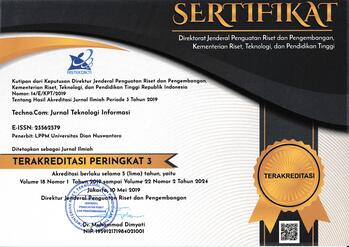Arsitektur U-Net pada Segmentasi Citra Hati sebagai Deteksi Dini Kanker Liver
Abstract
Keywords
Full Text:
PDFReferences
M. Rela, N. R. Suryakari, and P. R. Reddy, “Liver Tumor Segmentation and Classification: A Systematic Review,” Proc. 2020 IEEE-HYDCON Int. Conf. Eng. 4th Ind. Revolution, HYDCON 2020, pp. 21–26, 2020.
A. I. Falatehan, N. Hidayat, and K. C. Brata, “Sistem Pakar Diagnosis Penyakit Hati Menggunakan Metode Fuzzy Tsukamoto Berbasis Android,” J. Pengemb. Teknol. Inf. dan Ilmu Komput. Univ. Brawijaya, vol. 2, no. 8, pp. 2373–2381, 2018.
T. R. Latifatul Khairiah, Tursina, “Sistem Pakar Diagnosis Penyakit Hati Dengan Metode Dempster Shafer Berbasis Android,” J. Coding Sist. Komput. Untan, vol. 5, no. 2, pp. 57–66, 2017.
H. Sung et al., “Global Cancer Statistics 2020: GLOBOCAN Estimates of Incidence and Mortality Worldwide for 36 Cancers in 185 Countries,” CA. Cancer J. Clin., vol. 71, no. 3, pp. 209–249, 2021.
N. Alalwan, A. Abozeid, A. A. A. ElHabshy, and A. Alzahrani, “Efficient 3D Deep Learning Model for Medical Image Semantic Segmentation,” Alexandria Eng. J., vol. 60, no. 1, pp. 1231–1239, 2021.
A. Desiani, B. Suprihatin, S. Yahdin, A. I. Putri, and F. R. Husein, “Bi-path architecture of CNN segmentation and classification method for cervical cancer fisorders based on pap-smear images,” IAENG Int. J. Comput. Sci., vol. 48, no. 3, pp. 1–10, 2021.
A. A. Riadi, A. A. Chamid, and A. Sokhibi, “Analisis Komparasi Metode Perbaikan Kontras Berbasis Histogram Equalization Pada Citra Medis,” Simetris J. Tek. Mesin, Elektro dan Ilmu Komput., vol. 8, no. 1, pp. 383–388, 2017.
A. M. Anter and A. E. Hassenian, “CT liver tumor segmentation hybrid approach using neutrosophic sets, fast fuzzy c-means and adaptive watershed algorithm,” Artif. Intell. Med., vol. 97, no. September, pp. 105–117, 2019.
M. Rela, S. N. Rao, and P. R. Reddy, “Liver Tumor Segmentation using Superpixel based Fast Fuzzy C Means Clustering,” Int. J. Adv. Comput. Sci. Appl., vol. 11, no. 11, pp. 380–387, 2020.
L. Meng, Q. Zhang, and S. Bu, “Two?stage liver and tumor segmentation algorithm based on convolutional neural network,” Diagnostics, vol. 11, no. 10, 2021.
S. M. Anwar, S. Awan, S. Yousaf, and M. Majid, “Segmentation of liver tumor for computer aided diagnosis,” 2018 IEEE EMBS Conf. Biomed. Eng. Sci. IECBES 2018 - Proc., pp. 366–370, 2019.
J. Cai, “Segmentation and Diagnosis of Liver Carcinoma Based on Adaptive Scale-Kernel Fuzzy Clustering Model for CT Images,” J. Med. Syst., vol. 43, no. 11, 2019.
R. Zhang, Z. Zhou, W. Wu, C. C. Lin, P. H. Tsui, and S. Wu, “An improved fuzzy connectedness method for automatic three-dimensional liver vessel segmentation in CT images,” J. Healthc. Eng., vol. 2018, 2018.
M. Wang and W. Deng, “Deep visual domain adaptation: A survey,” Neurocomputing, vol. 312, no. April, pp. 135–153, 2018.
T. A. Soomro et al., “Deep learning models for retinal blood vessels segmentation: a review,” IEEE Access, vol. 7, pp. 71696–71717, 2019.
G. Du, X. Cao, J. Liang, X. Chen, and Y. Zhan, “Medical Image Segmentation based on U-Net: A Review,” J. Imaging Sci. Technol., vol. 64, no. 2, pp. 1–12, 2020.
T. Pranata, A. Desiani, B. Suprihatin, H. Hanum, and F. Efriliyanti, “Segmentation of the Lungs on X-Ray Thorax Image with CNN Architecture U-Net,” vol. 11, no. 2, pp. 101–111, 2022.
X. He, Z. Yu, T. Wang, B. Lei, and Y. Shi, “Dense deconvolution net: Multi path fusion and dense deconvolution for high resolution skin lesion segmentation,” Technol. Heal. Care, vol. 26, no. S1, pp. S307–S316, 2018.
N. Saeedizadeh, S. Minaee, R. Kafieh, S. Yazdani, and M. Sonka, “COVID TV-Unet: Segmenting COVID-19 chest CT images using connectivity imposed Unet,” Comput. Methods Programs Biomed. Updat., vol. 1, no. March, p. 100007, 2021.
L. Alzubaidi et al., Review of deep learning: concepts, CNN architectures, challenges, applications, future directions, vol. 8, no. 1. Springer International Publishing, 2021.
W. Chen, B. Yang, J. Li, and J. Wang, “An approach to detecting diabetic retinopathy based on integrated shallow convolutional neural networks,” IEEE Access, vol. 8, pp. 178552–178562, 2020.
M. M. Islam, T. N. Poly, B. A. Walther, H. C. Yang, and Y.-C. (Jack) Li, “Artificial intelligence in ophthalmology: a meta-analysis of deep learning models for retinal vessels segmentation,” J. Clin. Med., vol. 9, no. 4, p. 1018, 2020.
H. Ide and T. Kurita, “Improvement of learning for CNN with ReLU activation by sparse regularization,” Proc. Int. Jt. Conf. Neural Networks, vol. 2017-May, pp. 2684–2691, 2017.
J. Shi et al., “Improvement of damage segmentation based on pixel-level data balance using vgg-unet,” Appl. Sci., vol. 11, no. 2, pp. 1–17, 2021.
C. Wang, M. Gan, M. Zhang, and D. Li, “Adversarial convolutional network for esophageal tissue segmentation on OCT images,” Biomed. Opt. Express, vol. 11, no. 6, p. 3095, 2020.
R. A. Pangestu, B. Rahmat, and F. T. Anggraeny, “Implementasi Algoritma CNN untuk Klasifikasi Citra Lahan dan Perhitungan Luas,” Inform. dan Sist. Inf., vol. 1, no. 1, pp. 166–174, 2020.
L. Han, Y. Chen, J. Li, B. Zhong, Y. Lei, and M. Sun, “Liver segmentation with 2.5D perpendicular UNets,” Comput. Electr. Eng., vol. 91, no. January, p. 107118, 2021.
B. Kim and J. C. Ye, “Cycle-consistent adversarial network with polyphase U-Nets for liver lesion segmentation,” 1st Conf. Med. Imaging with Deep Learn., no. Midl, pp. 1–3, 2018.
J. Ma, Y. Deng, Z. Ma, K. Mao, and Y. Chen, “A Liver Segmentation Method Based on the Fusion of VNet and WGAN,” Comput. Math. Methods Med., vol. 2021, 2021.
X. Li, H. Chen, X. Qi, Q. Dou, C. W. Fu, and P. A. Heng, “H-DenseUNet: Hybrid Densely Connected UNet for Liver and Tumor Segmentation from CT Volumes,” IEEE Trans. Med. Imaging, vol. 37, no. 12, pp. 2663–2674, 2018.
DOI: https://doi.org/10.33633/tc.v21i4.6669
Article Metrics
Abstract view : 883 timesPDF - 518 times
Refbacks
- There are currently no refbacks.
Diterbitkan Oleh :
Jurnal Techno.Com terindex di :
Jurnal Teknologi Informasi Techno.Com (p-ISSN : 1412-2693, e-ISSN : 2356-2579) diterbitkan oleh LPPM Universitas Dian Nuswantoro Semarang. Jurnal ini di bawah lisensi Creative Commons Attribution 4.0 International License.













